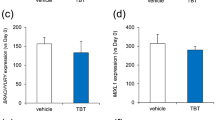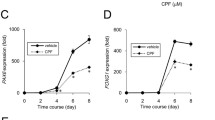Abstract
Methyl viologen is a highly effective contact herbicide, a neurotoxic compound and an inducer of reactive oxygen species, which generate oxidative stress in cells. Reactive oxygen species has been known to function as an important messenger in cell differentiation. In this study, we investigated the effect of methyl viologen on neural cell differentiation using pluripotent mouse embryonal carcinoma P19 cells, which reportedly differentiate into neural cells upon exposure to retinoic acid. Methyl viologen, an inducer of intracellular reactive oxygen species, induced the differentiation of P19 cells into neural cells in the presence of neurofilament. Reduced glutathione, an eliminator of reactive oxygen species, also induced neural differentiation in P19 cells. These results suggest that P19 cells differentiate into neural cells, conceivably independent of intracellular reactive oxygen species.




Similar content being viewed by others
References
Bae YS, Oh H, Rhee SG, Yoo YD (2011) Regulation of reactive oxygen species generation in cell signaling. Mol Cells 32:491–509
Bain G, Ray WJ, Yao M, Gottlieb DI (1994) From embryonal carcinoma cells to neurons: the P19 pathway. BioEssays 16:343–348
Bus JS, Aust SD, Gibson JE (1976) Paraquat toxicity: proposed mechanism of action involving lipid peroxidation. Environ Health Perspect 16:139–146
Castello PR, Drechsel DA, Patel M (2007) Mitochondria are a major source of paraquat-induced reactive oxygen species production in the brain. J Biol Chem 282:14186–14193
Chan SM, Weng AP, Tibshirani R, Aster JC, Utz PJ (2007) Notch signals positively regulate activity of the mTOR pathway in T-cell acute lymphoblastic leukemia. Blood 110:278–286
Chang L, Karin M (2001) Mammalian MAP kinase signaling cascades. Nature 410:37–40
Chiu HJ, Fischman DA, Hammerling U (2008) Vitamin A depletion causes oxidative stress, mitochondrial dysfunction, and PARP-1-dependent energy deprivation. FASEB J 22:3878–3887
Cory-Slechta DA, Thiruchelvam M, Richfield EK, Barlow BK, Brooks AI (2005) Developmental pesticide exposures and the Parkinson’s disease phenotype. Birth Defects Res A Clin Mol Teratol 73:136–139
Djukic M, Jovanovic MC, Ninkovic M, Vasiljevic I, Jovanovic M (2007) The role of nitric oxide in paraquat-induced oxidative stress in rat striatum. Ann Agric Environ Med 14:247–252
Ha HC, Thiagalingam A, Nelkin BD, Casero RA Jr (2000) Reactive oxygen species are critical for the growth and differentiation of medullary thyroid carcinoma cells. Clin Cancer Res 6:3783–3787
Jenner P (2003) Oxidative stress in Parkinson’s disease. Ann Neurol 53:S26–S36
Jones-Villeneuve EMV, McBurney MW, Rogers KA, Kalnins VI (1982) Retinoic acid induces embryonal carcinoma cells to differentiate into neurons and glial cells. J Cell Biol 94:253–262
Jones-Villeneuve EMV, Rudnicki MA, Harris JF, McBurney MW (1983) Retinoic acid-induced neural differentiation of embryonal carcinoma cells. Mol Cell Biol 3:2271–2279
Junttila MR, Li SP, Westermarck J (2008) Phosphatase-mediated crosstalk between MAPK signaling pathways in the regulation of cell survival. FASEB J 22:954–965
Kanda Y (2013) Investigation of the freely-available easy-to-use software “EZR” (Easy R) for medical statistics. Bone Marrow Transplant 48:452–458
Kondoh K, Sunadome K, Nishida E (2007) Notch signaling suppresses p38 MAPK activity via induction of MKP-1 in myogenesis. J Biol Chem 282:3058–3065
Lee HY, Walsh GL, Dawson MI, Hong WK, Kurie JM (1998) All-trans-retinoic acid inhibits Jun N-terminal kinase-dependent signaling pathways. J Biol Chem 273:7066–7071
Lee HY, Sueoka N, Hong WK, Mangelsdorf DJ, Claret FX, Kurie JM (1999) All-trans-retinoic acid inhibits Jun N-terminal kinase by increasing dual-specificity phosphatase activity. Mol Cell Biol 19:1973–1980
Leem YE, Choi HK, Jung SY, Kim BJ, Lee KY, Yoon K, Qin J, Kang JS, Kim ST (2011) Esco2 promotes neuronal differentiation by repressing Notch signaling. Cell Signal 23:1876–1884
Li J, Molkentin JD, Colbert MC (2001) Retinoic acid inhibits cardiac neural crest migration by blocking c-Jun N-terminal kinase activation. Dev Biol 232:351–361
Liou HH, Tsai MC, Chen CJ, Jeng JS, Chang YC, Chen SY, Chen RC (1997) Environmental risk factors and Parkinson’s disease: a case–control study in Taiwan. Neurology 48:1583–1588
Margolis AS, Porasuphatana S, Rosen GM (2000) Role of paraquat in the uncoupling of nitric oxide synthase. Biochim Biophys Acta 1524:253–257
Martindale JL, Holbrook NJ (2002) Cellular response to oxidative stress: signaling for suicide and survival. J Cell Physiol 192:1–15
McBurney MW (1993) P19 embryonal carcinoma cells. Int J Dev Biol 37:135–140
McBurney MW, Jones-Villeneuve EM, Edwards MK, Anderson PJ (1982) Control of muscle and neuronal differentiation in a cultured embryonal carcinoma cell line. Nature 299:165–167
McCarthy S, Somayajulu M, Sikorska M, Borowy-Borowski H, Pandey S (2004) Paraquat induces oxidative stress and neuronal cell death; neuroprotection by water-soluble coenzyme Q10. Toxicol Appl Pharmacol 201:21–31
Monteiro HP, Stern A (1996) Redox modulation of tyrosine phosphorylation-dependent signal transduction pathways. Free Radic Biol Med 21:323–333
Olguín-Albuerne M, Morán J (2015) ROS produced by NOX2 control in vitro development of cerebellar granule neurons development. ASN Neuro 7:1759091415578712. doi:10.1177/1759091415578712
Posecion NC, Ostrea EM, Bielawski DM (2008) Quantitative determination of paraquat in meconium by sodium borohydride-nickel chloride chemical reduction and gas chromatography/mass spectrometry (GC/MS). J Chromatogr B Analyt Technol Biomed Life Sci 862:93–99
Reffas S, Schlegel W (2000) Compartment-specific regulation of extracellular signal-regulated kinase (ERK) and c-Jun N-terminal kinase (JNK) mitogen-activated protein kinases (MAPKs) by ERK-dependent and non-ERK-dependent inductions of MAPK phosphatase (MKP)-3 and MKP-1 in differentiating P19 cells. Biochem J 352:701–708
Sagara J, Makino N (2008) Glutathione induces neuronal differentiation in rat bone marrow stromal cells. Neurochem Res 33:16–21
Sauer H, Wartenberg M, Hescheler J (2001) Reactive oxygen species as intracellular messengers during cell growth and differentiation. Cell Physiol Biochem 11:173–186
Son Y, Cheong YK, Kim NH, Chung HT, Kang DG, Pae HO (2011) Mitogen-activated protein kinases and reactive oxygen species: how can ROS activate MAPK pathways? J Signal Transduct 2011:792639
Sun Y, Oberley LW (1996) Redox regulation of transcriptional activators. Free Radi Biol Med 21:335–348
Suntres ZE (2002) Role of antioxidants in paraquat toxicity. Toxicology 180:65–77
Suzuki YJ, Forman HJ, Sevanian A (1997) Oxidants as stimulators of signal transduction. Free Radic Biol Med 22:269–285
Talbot AR, Fu CC, Hsieh MF (1988) Paraquat intoxication during pregnancy: a report of 9 cases. Vet Hum Toxicol 30:12–17
Tanner CM, Kamel F, Ross GW, Hoppin JA, Goldman SM, Korell M, Marras C, Bhudhikanok GS, Kasten M, Chade AR, Comyns K, Richards MB, Meng C, Priestley B, Fernandez HH, Cambi F, Umbach DM, Blair A, Sandler DP, Langston JW (2011) Rotenone, paraquat, and Parkinson’s disease. Environ Health Perspect 119:866–872
Tsatsakis AM, Perakis K, Koumantakis E (1996) Experience with acute paraquat poisoning in Crete. Vet Human Toxicol 38:113–117
Tsukamoto M, Tampo Y, Sawada M, Yonaha M (2002) Paraquat-induced oxidative stress and dysfunction of the glutathione redox cycle in pulmonary microvascular endothelial cells. Toxicol Appl Pharmacol 178:82–92
Wu P, Jiang C, Shen Q, Hu Y (2009) Systematic gene expression profile of hypothalamus in calorie-restricted mice implicates the involvement of mTOR signaling in neuroprotective activity. Mech Ageing Dev 130:602–610
Acknowledgments
We are grateful to Koji Ogawa for his technical advice in cell culture.
Author information
Authors and Affiliations
Corresponding author
Additional information
Editor: Tetsuji Okamoto
Rights and permissions
About this article
Cite this article
Shimada, E., Ogawa, T., Tsutsui, K. et al. Methyl viologen induces neural differentiation on murine P19 cells. In Vitro Cell.Dev.Biol.-Animal 52, 466–472 (2016). https://doi.org/10.1007/s11626-016-0001-9
Received:
Accepted:
Published:
Issue Date:
DOI: https://doi.org/10.1007/s11626-016-0001-9




